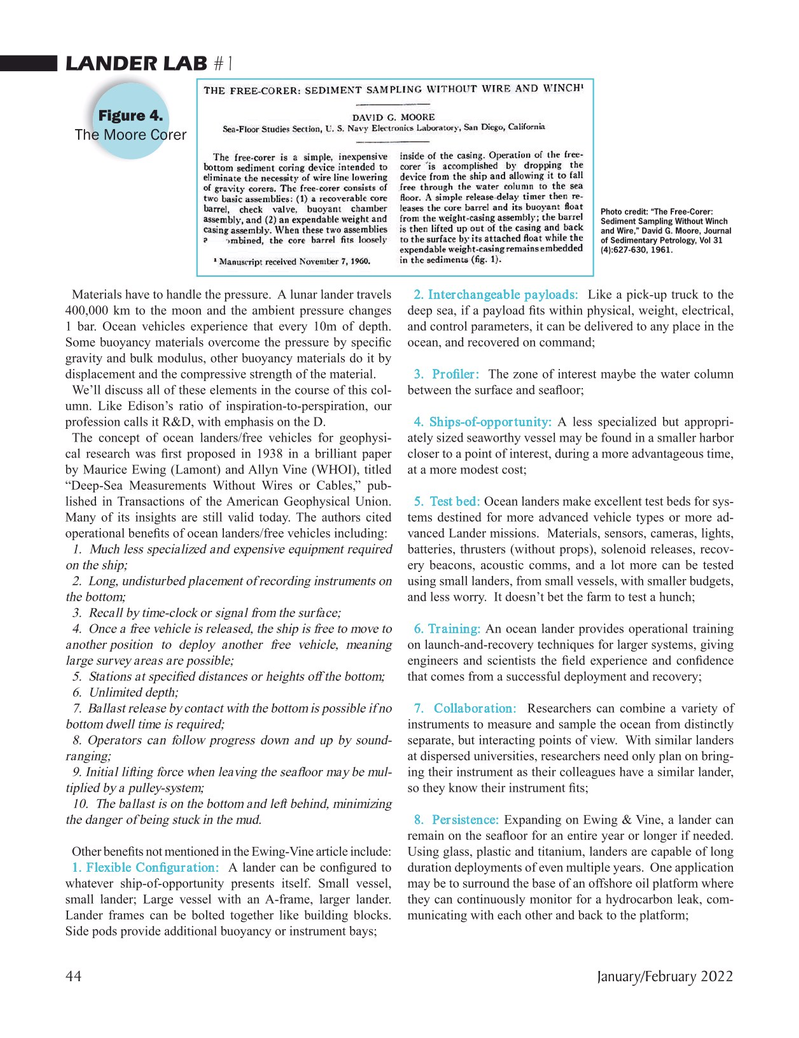
Page 44: of Marine Technology Magazine (January 2022)
Read this page in Pdf, Flash or Html5 edition of January 2022 Marine Technology Magazine
LANDER LAB #1
Figure 4.
The Moore Corer
Photo credit: “The Free-Corer:
Sediment Sampling Without Winch and Wire,” David G. Moore, Journal of Sedimentary Petrology, Vol 31 (4):627-630, 1961.
Materials have to handle the pressure. A lunar lander travels 2. Interchangeable payloads: Like a pick-up truck to the 400,000 km to the moon and the ambient pressure changes deep sea, if a payload ? ts within physical, weight, electrical, 1 bar. Ocean vehicles experience that every 10m of depth. and control parameters, it can be delivered to any place in the
Some buoyancy materials overcome the pressure by speci? c ocean, and recovered on command; gravity and bulk modulus, other buoyancy materials do it by displacement and the compressive strength of the material. 3. Pro? ler: The zone of interest maybe the water column
We’ll discuss all of these elements in the course of this col- between the surface and sea? oor; umn. Like Edison’s ratio of inspiration-to-perspiration, our profession calls it R&D, with emphasis on the D. 4. Ships-of-opportunity: A less specialized but appropri-
The concept of ocean landers/free vehicles for geophysi- ately sized seaworthy vessel may be found in a smaller harbor cal research was ? rst proposed in 1938 in a brilliant paper closer to a point of interest, during a more advantageous time, by Maurice Ewing (Lamont) and Allyn Vine (WHOI), titled at a more modest cost; “Deep-Sea Measurements Without Wires or Cables,” pub- lished in Transactions of the American Geophysical Union. 5. Test bed: Ocean landers make excellent test beds for sys-
Many of its insights are still valid today. The authors cited tems destined for more advanced vehicle types or more ad- operational bene? ts of ocean landers/free vehicles including: vanced Lander missions. Materials, sensors, cameras, lights, 1. Much less specialized and expensive equipment required batteries, thrusters (without props), solenoid releases, recov- on the ship; ery beacons, acoustic comms, and a lot more can be tested 2. Long, undisturbed placement of recording instruments on using small landers, from small vessels, with smaller budgets, the bottom; and less worry. It doesn’t bet the farm to test a hunch; 3. Recall by time-clock or signal from the surface; 4. Once a free vehicle is released, the ship is free to move to 6. Training: An ocean lander provides operational training another position to deploy another free vehicle, meaning on launch-and-recovery techniques for larger systems, giving large survey areas are possible; engineers and scientists the ? eld experience and con? dence 5. Stations at speci? ed distances or heights off the bottom; that comes from a successful deployment and recovery; 6. Unlimited depth; 7. Ballast release by contact with the bottom is possible if no 7. Collaboration: Researchers can combine a variety of bottom dwell time is required; instruments to measure and sample the ocean from distinctly 8. Operators can follow progress down and up by sound- separate, but interacting points of view. With similar landers ranging; at dispersed universities, researchers need only plan on bring- 9. Initial lifting force when leaving the sea? oor may be mul- ing their instrument as their colleagues have a similar lander, tiplied by a pulley-system; so they know their instrument ? ts; 10. The ballast is on the bottom and left behind, minimizing the danger of being stuck in the mud. 8. Persistence: Expanding on Ewing & Vine, a lander can remain on the sea? oor for an entire year or longer if needed.
Other bene? ts not mentioned in the Ewing-Vine article include: Using glass, plastic and titanium, landers are capable of long 1. Flexible Con? guration: A lander can be con? gured to duration deployments of even multiple years. One application whatever ship-of-opportunity presents itself. Small vessel, may be to surround the base of an offshore oil platform where small lander; Large vessel with an A-frame, larger lander. they can continuously monitor for a hydrocarbon leak, com-
Lander frames can be bolted together like building blocks. municating with each other and back to the platform;
Side pods provide additional buoyancy or instrument bays; 44 January/February 2022
MTR #1 (34-49).indd 44 1/25/2022 9:16:36 AM

 43
43

 45
45
